The Ultimate Chest Workout Program at Gym and Home. One of the most noticeable parts of the body, the chest is responsible for many arm movements such as throwing, pushing, and hitting. A strong, well-defined chest is the hallmark of a great training program. The major chest muscles are the pectoralis major and pectoralis minor. These strong muscles move the arms across the body and toward the waist. The pecs allow for several different movements, and there are several different ways to strengthen them. All pressing movements require your pecs, triceps, and anterior deltoids to play a role in the movement. So trying to isolate your pecs is not always easy. That also means that grouping exercises together to prevent overtraining will be an important part of your workout week. If you really want great upper body development, you will need to use both the pressing movements and the isolated pec exercises found in this chapter.
The main lift, and perhaps the single most practiced exercise, is the bench press. No other exercise is more heralded than this spectacle of strength and prowess. The bench press works not only the pecs but also several other muscles. In addition to developing the chest, the bench press helps develop many of the muscles that act on the shoulder joint, including the anterior deltoid and the triceps.
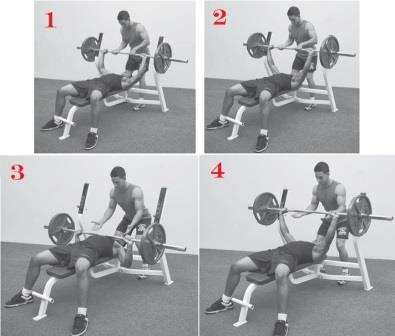 There are several variations of the bench press and many other chest exercises. Each exercise works the pecs and supporting muscles slightly differently. Remember, specificity requires that you choose exercises that reflect your needs and goals.
There are several variations of the bench press and many other chest exercises. Each exercise works the pecs and supporting muscles slightly differently. Remember, specificity requires that you choose exercises that reflect your needs and goals.
Incline Bench Press
The incline press works the upper pecs a little more than the flat bench press.
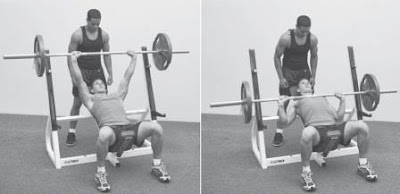
Dumbbell Bench Press
This movement emphasizes the muscles that help stabilize the shoulders. The weights will feel awkward when you do the dumbbell bench press for the first time. Controlling them is the key.

Single-Arm Bench Press
When looking to increase your challenge, try performing single-arm variations of the flat and incline bench presses. When using dumbbells, the bench press starts at the chest, unlike the barbell version, which comes off the rack.
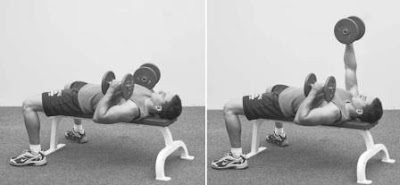 For a more difficult challenge, instead of resting the nonmoving dumbbell atyour chest, try keeping it locked out at arm’s length while pressing and lowering the other dumbbell. To alternate this version, start by pressing both dumbbells up, then lowering and raising one, then lowering and raising the other.
For a more difficult challenge, instead of resting the nonmoving dumbbell atyour chest, try keeping it locked out at arm’s length while pressing and lowering the other dumbbell. To alternate this version, start by pressing both dumbbells up, then lowering and raising one, then lowering and raising the other.
Unstable Bench Press
Unstable training is more sport specific and for advanced lifters, but trying these same lifts on a stability ball will increase your challenge significantly. Although some people use this exercise for core development, the added difficulty is at your shoulder girdle and will both train and challenge your rotator cuff muscles. Remember, though, if your goal is to increase pec size and strength, training on an unstable surface is not the way to go. Also, before you attempt to do any move on an unstable surface, you should be able to perform its stable version flawlessly.
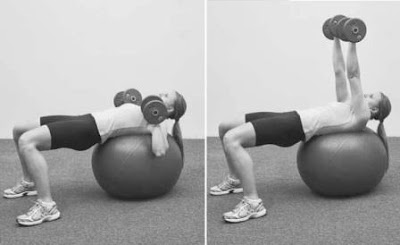
The pec fly is another exercise that isolates the pecs. It allows for greater range of motion than the bench press. With the cable or machine fly, the arms are extended out to the sides at chest height, with the elbows straight out or bent 90 degrees depending on the machine you are using.
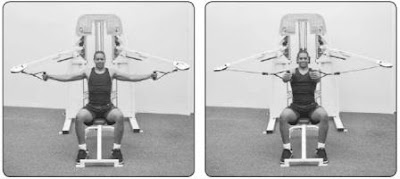
The dumbbell pec fly is more difficult than the machine pec fly because it requires you to stabilize your upper body and create the path the dumbbells follow rather than having a fixed line.
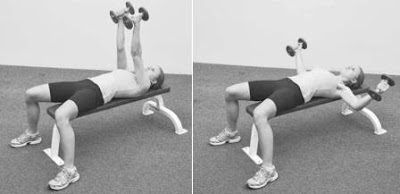
Cable Cross
The cable cross is perhaps the most flamboyant of chest exercises. It is a good way to work the pecs and can be performed one arm at a time.
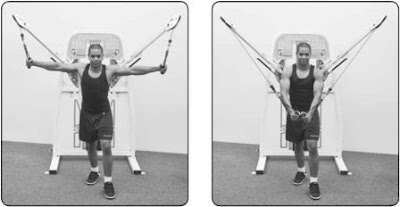
Veteran bench pressers know a few tricks for successful benching. The ultimate goal, especially for men, is to load up the plates, trying to hit the legendary three-plate pinnacle—three 45-pound (20 kg) plates per side, plus the 45-pound bar, totaling 315 pounds (140 kg). Although that may not be in your sights now, it may be in your future. Don’t try to lift like the veterans until your technique is solid and you have developed sufficient strength.
Grip all barbells and dumbbells in a monkey grip, with your thumb wrapped around the bar or dumbbell. Placement of your hands on the bar is also important. Generally, a narrow grip involves the triceps more, whereas a wider grip involves more of the pecs.
The key to good technique is to get into a solid, tight position on the bench. Keep your body in contact with the bench throughout the entire pressing movement. Use your feet for support; placing them on the bench reduces stability and decreases the emphasis on the working muscles. Position your feet a little wider than shoulder-width apart and slightly back. Pull your shoulders back to form a solid base, and keep them in check throughout the movement.
Control the descent of the weight. A controlled descent allows the muscles to build up elastic energy that will help lift the bar back up. As you begin to drive the weight up, push your body back into the bench and flatten your shoulders. Don’t bounce the weight off your chest or use momentum to move the weight, as this can lead to injury and loss of control.
If you are not heading down to the gym and still want to get a great workout for your chest, you have several ways to do it in your own home. First, never forget the power of your own body weight as resistance. Push-ups are great standbys and still used in most strength programs. If you are very strong, try elevating your legs by putting them on a bench or chair so that more body weight is forward. Another great way to increase the difficulty is to perform the reps with your hands very close together or very wide apart.
If you have difficulty with regular push-ups, you can modify the push-up to make it easier. To reduce the amount of body weight you must support, place your feet on the floor and your hands on a chair or on a step to take a more upright position. If you want to increase the challenge, you can use a balance disc or med ball as the base support for your hands. This method allows you to target the same muscles and perform the same general movement. This is a great addition at the gym as well. And if you have resistance tubing, fix the middle of the tubing around a bedpost or banister, grab the handles with your back against the rail, and perform your reps standing up. Special resistance tubing is available that can be hooked to a doorknob.
For additional variety, try alternating between exercises within your workout or within your training week. For example, perform flat bench presses one workout and incline bench presses the next. Perform cable crosses between bench presses and incline presses. The combinations are limited only by your imagination. The bench press incorporates so many muscles that you are bound to work your chest well. Remember, muscles will begin to tire when you perform multiple sets of several exercises. Adjust your weights accordingly.
Don’t be afraid to change things. You don’t always have to start with the bench press on Monday. Try one of the popular combinations shown in the table. Routine 1 is good for general fitness, routine 2 is appropriate for strength development, and routine 3 is a good change of pace.
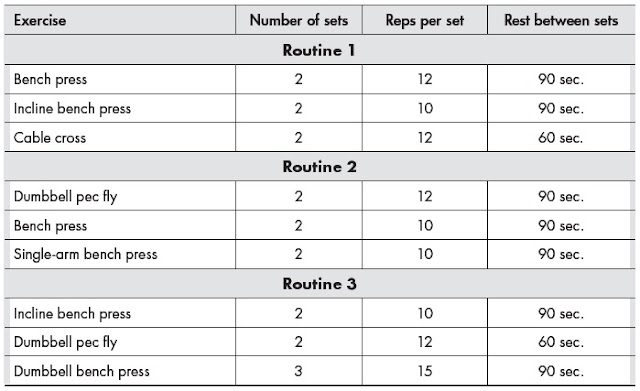 That's the article about The Ultimate Chest Workout Program at Gym and Home. Hopefully, this article useful for all readers. Don't forget to see another interesting article in this website. Thanks.
That's the article about The Ultimate Chest Workout Program at Gym and Home. Hopefully, this article useful for all readers. Don't forget to see another interesting article in this website. Thanks.
Ultimate Chest Workout at Gym
Bench Press
The motion of the bench press resembles an upside-down push-up. This exercise requires a great deal of concentration and arm coordination. Though the free weight version of the bench press is described here, some gyms may have a machine bench press option. It is important that you follow proper technique and start with a weight you can handle.
- Lie on the weight bench. Grab the bar, hands shoulder-width or a little wider apart. Keep your feet on the floor. Keep your shoulders, buttocks, and head against the bench at all times. To relieve the pressure on your lower back, it should have a slight arch. You should be able to slide your hand under your lower back.
- Inhale deeply, and remove the bar from the rack. Pause for two counts, then begin to lower the weight toward your chest.
- Lower the bar steadily, and pause for two counts when it touches your chest. The bar should cross at or slightly above your nipples.
- To begin the ascent, rapidly drive the weight up, maintaining a constant speed. Exhale as you lift the weight. Continue to lift the weight until your arms are fully extended. The bar will naturally follow an arc and end up just over your neck. Although many people think locking the arms is bad, it is important to move the bar through the complete range of motion. A gentle lock is acceptable and ensures that you have completed the upward motion.

Incline Bench Press
The incline press works the upper pecs a little more than the flat bench press.
- Set the bench at about a 45-degree angle. Decreasing the angle puts more emphasis on the middle chest and front shoulders; increasing the angle puts more emphasis on the upper chest and middle shoulders and triceps.
- Lower and raise the weight as you did in the bench press. The bar should touch a little higher on your chest, near your collarbone.

Dumbbell Bench Press
This movement emphasizes the muscles that help stabilize the shoulders. The weights will feel awkward when you do the dumbbell bench press for the first time. Controlling them is the key.
- Lie on your back on a flat bench. Dig your shoulders into the bench, and pull your shoulder blades together. This tightens your body, lending additional support to the shoulders.
- Start with a dumbbell in each hand, palms turned forward, the dumbbells over your chest, and your elbows away from your body.
- Press the dumbbells by extending your arms.
- Lower the dumbbells back to the starting position. If you feel the dumbbells getting squirrelly on you, try to bring the dumbbells together when you press them.

Single-Arm Bench Press
When looking to increase your challenge, try performing single-arm variations of the flat and incline bench presses. When using dumbbells, the bench press starts at the chest, unlike the barbell version, which comes off the rack.
- To get the dumbbells to the starting position, rest the dumbbells on your knees while you are seated at the end of the bench. Lie backward on the bench, and pull the dumbbells while simultaneously raising your knees up to push the dumbbells back toward you as you lie down. Tighten your torso, and use the same body position as for the incline press.
- While keeping one dumbbell on your chest, press the other one straight up until your arm is fully extended. Pause for two counts then lower.
- You have the option of alternating arms or completing all your reps with one arm first. Generally, alternating ensures that both arms fatigue at a similar rate.

Unstable Bench Press
Unstable training is more sport specific and for advanced lifters, but trying these same lifts on a stability ball will increase your challenge significantly. Although some people use this exercise for core development, the added difficulty is at your shoulder girdle and will both train and challenge your rotator cuff muscles. Remember, though, if your goal is to increase pec size and strength, training on an unstable surface is not the way to go. Also, before you attempt to do any move on an unstable surface, you should be able to perform its stable version flawlessly.

- Start by grabbing a pair of dumbbells (use lighter ones than you would use on a stable surface) and sitting at the base of a stability ball.
- Bring the dumbbells up to shoulder height. Walk your feet out from the stability ball so that you make a bridge, with your shoulders and back on the ball, your torso extended, and your feet flat on the ground, your knees at 90 degrees.
- Press the dumbbells up to arm’s length while maintaining a tight torso. Hold for two counts and bring back down. You can perform single-arm versions of this exercise as well.
The pec fly is another exercise that isolates the pecs. It allows for greater range of motion than the bench press. With the cable or machine fly, the arms are extended out to the sides at chest height, with the elbows straight out or bent 90 degrees depending on the machine you are using.

- If you are using a cable machine or your machine has handles, grab the handles and extend your arms leaving a slight bend at the elbow. For a machine with pads, turn your palms so they face forward, and place your arms against the pads so that your lower arm, hands, and elbows are in complete contact.
- Squeeze the handles or pads toward each other, applying equal force to both. In the fully contracted position, the handles or pads should come directly in front of you. (Touching them together is fine.)
The dumbbell pec fly is more difficult than the machine pec fly because it requires you to stabilize your upper body and create the path the dumbbells follow rather than having a fixed line.
- Lie on a flat weight bench with your arms fully extended over your chest. With the dumbbells in your hands, turn your palms inward and touch the dumbbells together.
- Keeping a slight bend in your elbows, pull the dumbbells apart until your upper arms are parallel to the ground.
- Pause for two counts at the bottom position.
- Using a bear-hugging motion, return the dumbbells to the top.

Cable Cross
The cable cross is perhaps the most flamboyant of chest exercises. It is a good way to work the pecs and can be performed one arm at a time.
- Stand in the middle of the cable machine, with arms extended to the sides at shoulder height. Position one foot ahead of the other to create stability.
- Grab the machine handles, palms down, and pull toward the middle of your body, keeping your elbows slightly bent. Keep a slight bend in your knees, and lean slightly forward.
- Cross palms or bring your hands together about 6 to 12 inches (15 to 30 cm) in front of your belly button.
- Release the handles upward and backward to return to the starting position.

Chest Workout Program at The Gym
Train SmartVeteran bench pressers know a few tricks for successful benching. The ultimate goal, especially for men, is to load up the plates, trying to hit the legendary three-plate pinnacle—three 45-pound (20 kg) plates per side, plus the 45-pound bar, totaling 315 pounds (140 kg). Although that may not be in your sights now, it may be in your future. Don’t try to lift like the veterans until your technique is solid and you have developed sufficient strength.
Grip all barbells and dumbbells in a monkey grip, with your thumb wrapped around the bar or dumbbell. Placement of your hands on the bar is also important. Generally, a narrow grip involves the triceps more, whereas a wider grip involves more of the pecs.
The key to good technique is to get into a solid, tight position on the bench. Keep your body in contact with the bench throughout the entire pressing movement. Use your feet for support; placing them on the bench reduces stability and decreases the emphasis on the working muscles. Position your feet a little wider than shoulder-width apart and slightly back. Pull your shoulders back to form a solid base, and keep them in check throughout the movement.
Control the descent of the weight. A controlled descent allows the muscles to build up elastic energy that will help lift the bar back up. As you begin to drive the weight up, push your body back into the bench and flatten your shoulders. Don’t bounce the weight off your chest or use momentum to move the weight, as this can lead to injury and loss of control.
Chest Workout at Home
Practice Your Push-UpsIf you are not heading down to the gym and still want to get a great workout for your chest, you have several ways to do it in your own home. First, never forget the power of your own body weight as resistance. Push-ups are great standbys and still used in most strength programs. If you are very strong, try elevating your legs by putting them on a bench or chair so that more body weight is forward. Another great way to increase the difficulty is to perform the reps with your hands very close together or very wide apart.
If you have difficulty with regular push-ups, you can modify the push-up to make it easier. To reduce the amount of body weight you must support, place your feet on the floor and your hands on a chair or on a step to take a more upright position. If you want to increase the challenge, you can use a balance disc or med ball as the base support for your hands. This method allows you to target the same muscles and perform the same general movement. This is a great addition at the gym as well. And if you have resistance tubing, fix the middle of the tubing around a bedpost or banister, grab the handles with your back against the rail, and perform your reps standing up. Special resistance tubing is available that can be hooked to a doorknob.
The Example to Create a Chest Routine
The bench press is a great stand-alone exercise, but when it’s combined with other exercises, you can reach new levels in chest development. The bench press is easily coupled with the pec fly. To show your pecs who’s boss, try a pre- or postexhaust training routine (see page 188 and 189). Simply perform a set of pec flys immediately before (preexhaust) or after (postexhaust) the bench press. Allow only enough rest between exercises to move to the next exercise.For additional variety, try alternating between exercises within your workout or within your training week. For example, perform flat bench presses one workout and incline bench presses the next. Perform cable crosses between bench presses and incline presses. The combinations are limited only by your imagination. The bench press incorporates so many muscles that you are bound to work your chest well. Remember, muscles will begin to tire when you perform multiple sets of several exercises. Adjust your weights accordingly.
Don’t be afraid to change things. You don’t always have to start with the bench press on Monday. Try one of the popular combinations shown in the table. Routine 1 is good for general fitness, routine 2 is appropriate for strength development, and routine 3 is a good change of pace.

